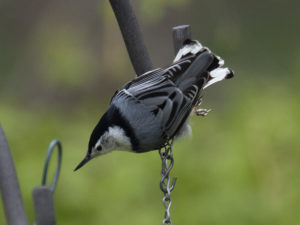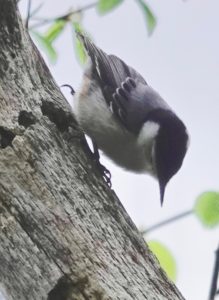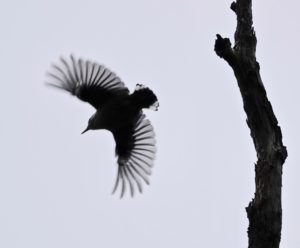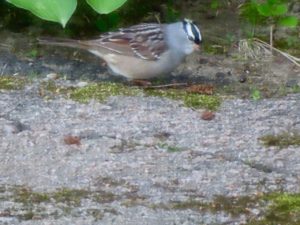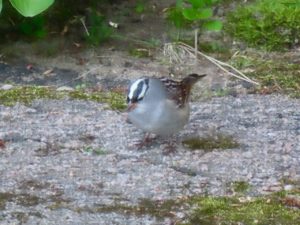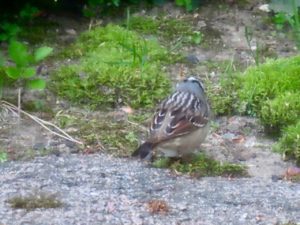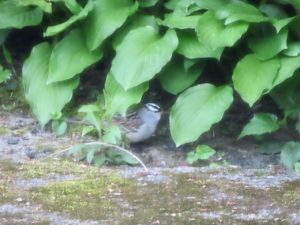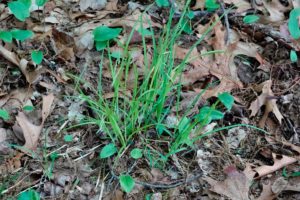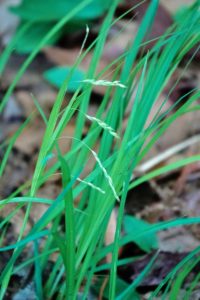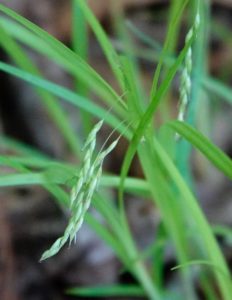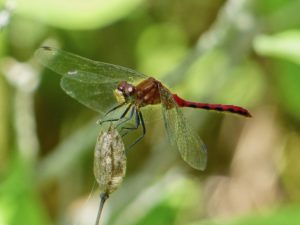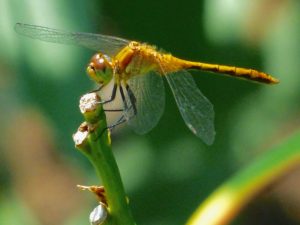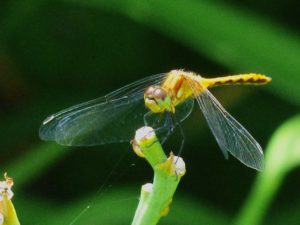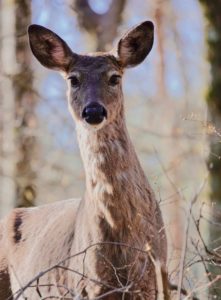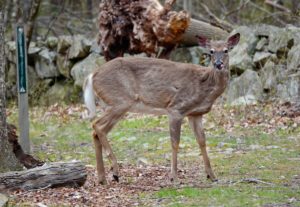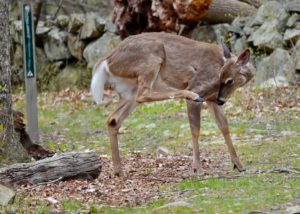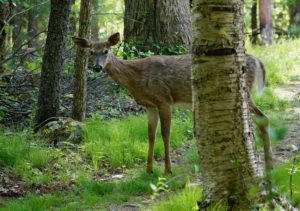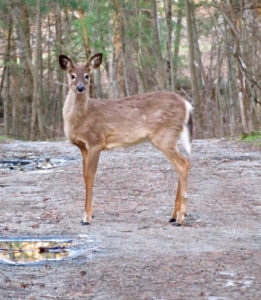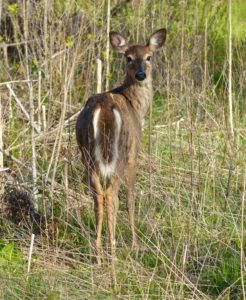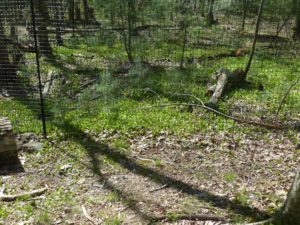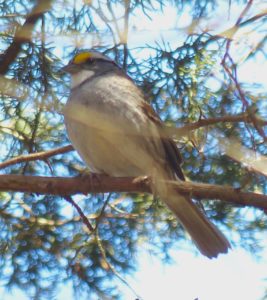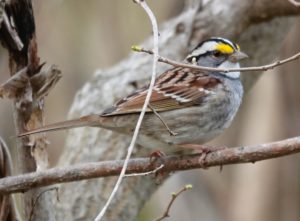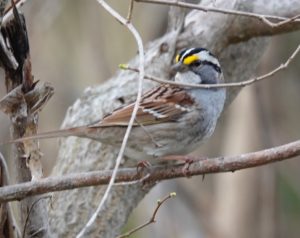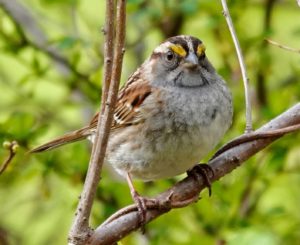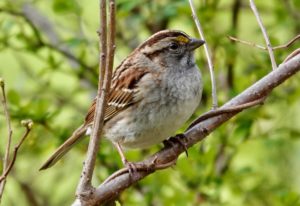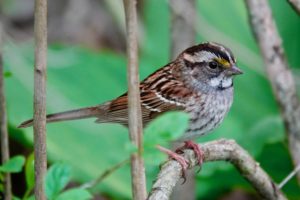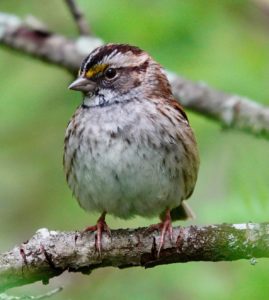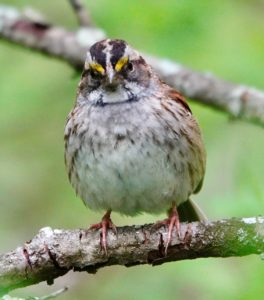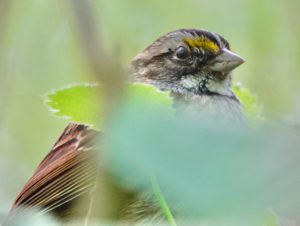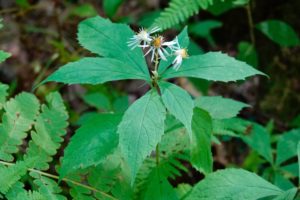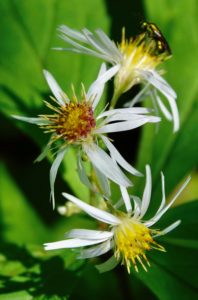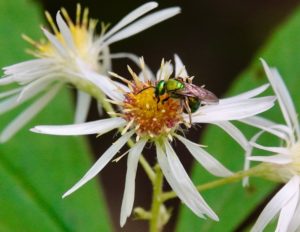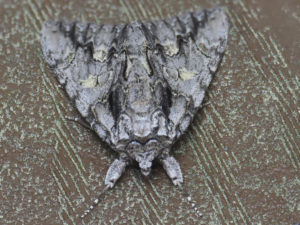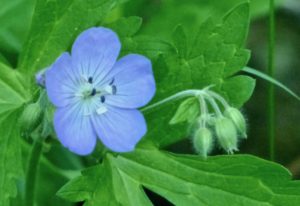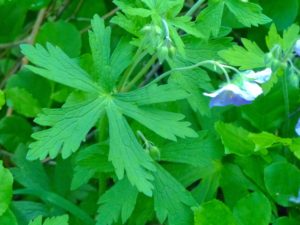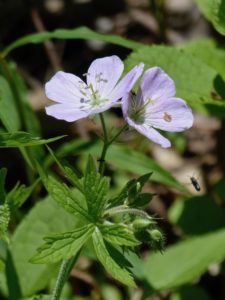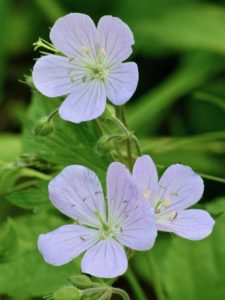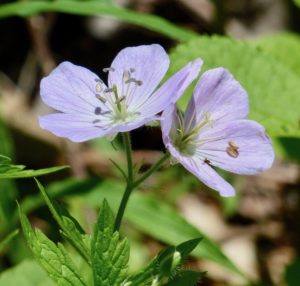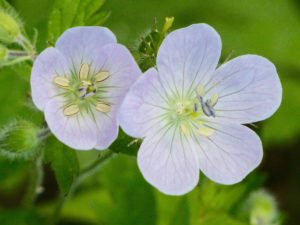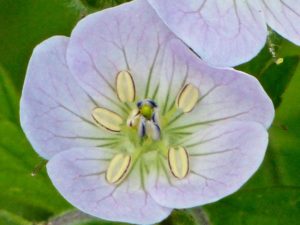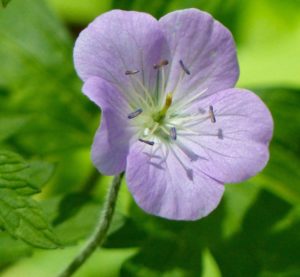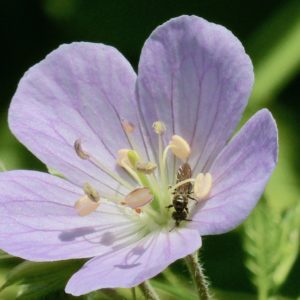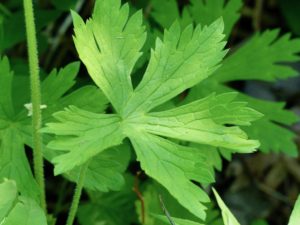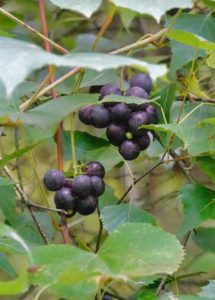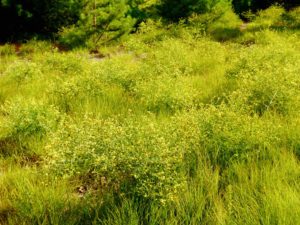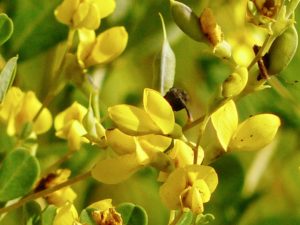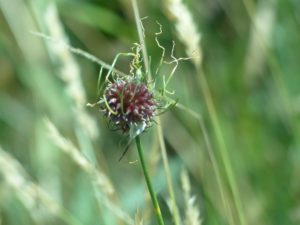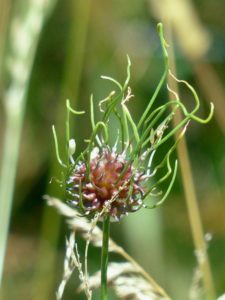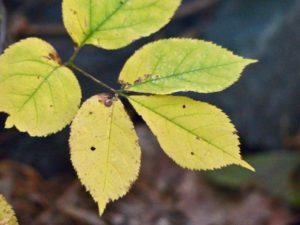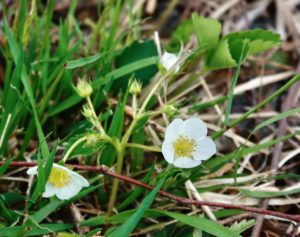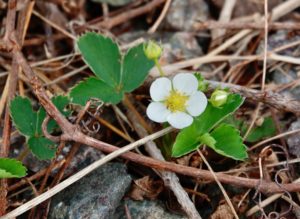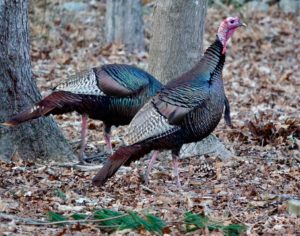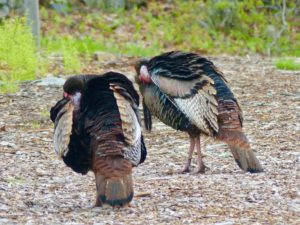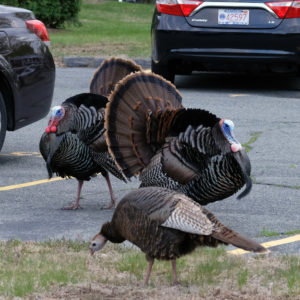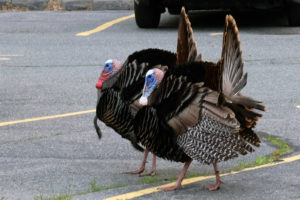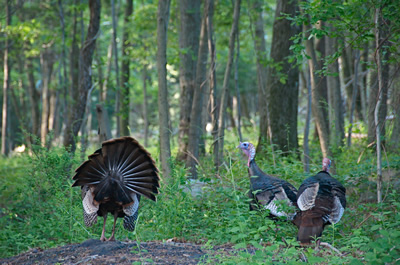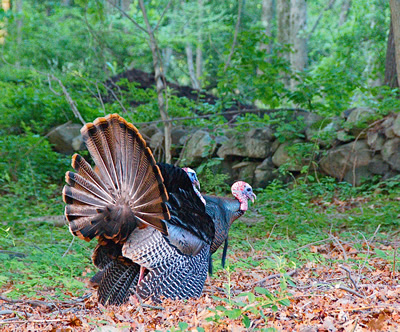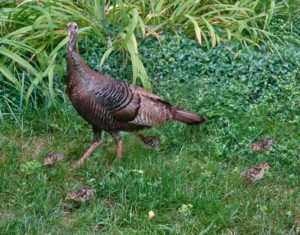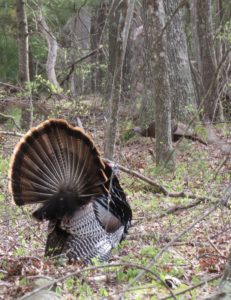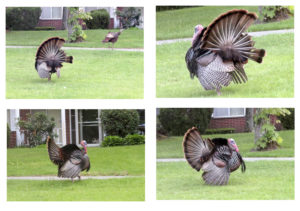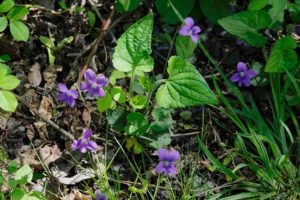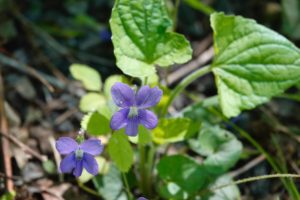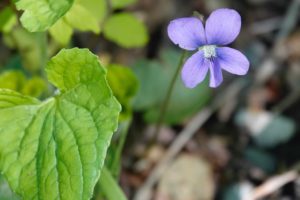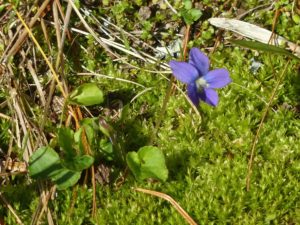Sightings grid
Observer: Josh Simons
Observation Date: 5/10/20
Observation Time: 1:15 p.m.
Observation Location: Moose Hill area
Common Name: White-breasted nuthatch
Scientific Name: Sitta carolinensis
Comments: White-breasted nuthatches are year-round Sharon residents. Learn to identify their nasal call.
More Information: All About Birds: White-breasted Nuthatch
Observer: Paul Lauenstein
Observation Date: 5/15/20
Observation Time: 7:50 a.m.
Observation Location: conservation land near Lakeview & Morse Sts.
Common Name: White-breasted nuthatch
Scientific Name: Sitta carolinensis
Comments: Here’s a lucky shot of a white-breasted nuthatch in flight.
More Information: All About Birds: White-breasted Nuthatch
Observer: Deb Radovsky
Observation Date: 5/9/23
Observation Time: 7:00 p.m.
Observation Location: Paul Revere Rd., Sharon
Common Name: White-crowned sparrow
Scientific Name: Zonotrichia leucophrys
Comments: White-crowned sparrows migrate through Sharon every spring en route to their nesting grounds farther north.
More Information: All About Birds
Observer: Paul Lauenstein
Observation Date: 5/25/23
Observation Time: 7:00 a.m.
Observation Location: Moose Hill Audubon Wildlife Sanctuary
Common Name: White-edged Sedge
Scientific Name: Carex debilis
Comments: The drooping seed stalks are characteristic.
More Information: Go Botany
Observer: Paul Lauenstein
Observation Date: 7/8/13
Observation Time: 5:40 p.m.
Observation Location: Gavins Pond area
Common Name: White-faced Meadowhawk dragonfly
Scientific Name: Sympetrum obtrusum
Comments: Males are red. Very similar to Ruby Meadowhawk and Cherry-faced Meadowhawk. This species seems to be in decline.
More Information: Nature Search
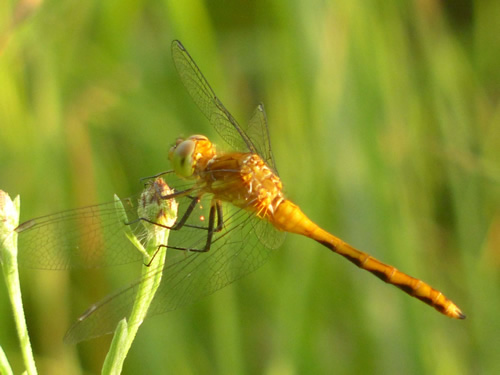
Two more photos taken 7/19/13 at about 5:30 where Turning Mill Brook flows under Wolomolopoag Street:
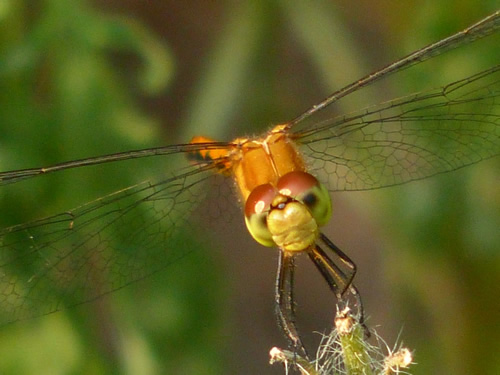
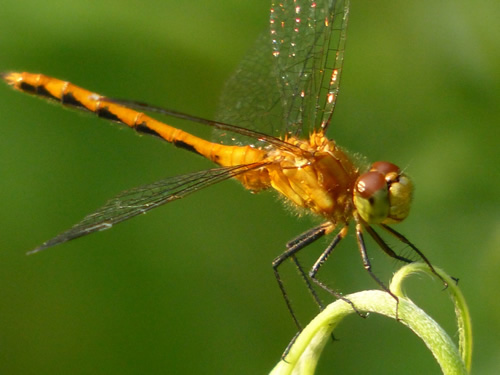
Observer: Paul Lauenstein
Observation Date: 8/11/12
Observation Time: 11:30 a.m.
Observation Location: Gavins Pond Road bridge over Billings Brook
Common Name: White-faced Meadowhawk dragonfly
Scientific Name: Sympetrum obtrusum
Comments: Adult males are identifiable by a distinctive pure white face and red body. Juveniles and younger females have a yellow abdomen. Older females have olive-brown or reddish-brown abdomen.
More Information: Wikipedia
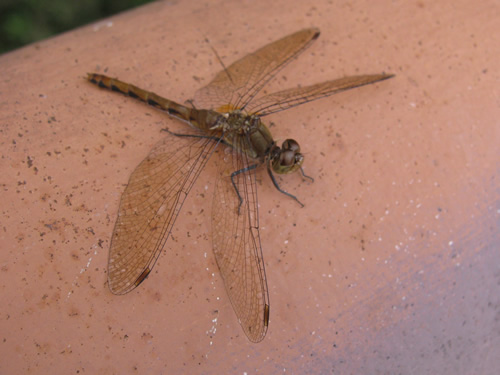
Observer: Paul Lauenstein
Observation Date: 8/15/18
Observation Time: 1:15 p.m.
Observation Location: Moose Hill Audubon Wildlife Sanctuary
Common Name: White-faced Meadowhawk dragonfly (male)
Scientific Name: Sympetrum obtrusum
Comments: Juveniles and females have yellow abdomens. Males are red. Similar to Ruby Meadowhawk and Cherry-faced Meadowhawk, but white-faced meadowhawks have a distinctive white face.
More Information: Wikipedia
Observer: Paul Lauenstein
Observation Date: 8/4/17
Observation Time: 1:55 p.m.
Observation Location: 4 Gavins Pond Road
Common Name: White-faced Meadowhawk dragonfly
Scientific Name: Sympetrum obtrusum
Comments: Juveniles and females have yellow abdomens. Males are red. Similar to Ruby Meadowhawk and Cherry-faced Meadowhawk, but white-faced meadowhawks have a distinctive white face.
More Information: Wikipedia
Observer: Paul Lauenstein
Observation Date: 4/12/14
Observation Time: 2:00 p.m.
Observation Location: 4 Gavins Pond Road (back yard)
Common Name: White-footed mouse
Scientific Name: Peromyscus leucopus
Comments: This juvenile mouse was in our garden.
More Information: Wikipedia
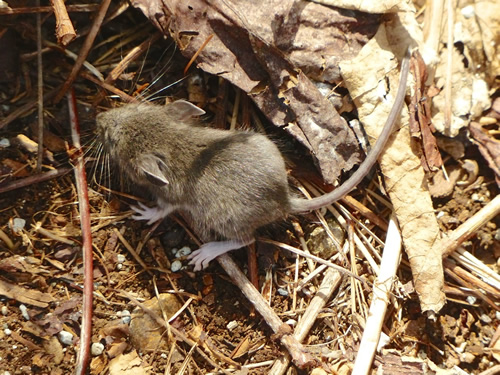
Observer: Peter Higgins
Observation Date: 11/26/08 & 11/30/08
Observation Time: 7:30 a.m.
Observation Location: Moose Hill Farm
Common Name: White-Tailed Deer
Scientific Name: Odocoileus virginianus
Comments: Moose Hill Farm is a wonderful gift to the town, I get up early and see deer, turkeys, and coyotes on a regular basis.
More Information: University of Michigan Museum of Zoology “Animal Diversity Web”


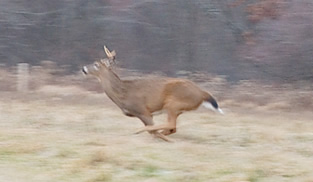
Observer: Paul Lauenstein
Observation Date: 4/29/20
Observation Time: 7:55 a.m.
Observation Location: Moose Hill Farm (TTOR)
Common Name: White-tailed Deer
Scientific Name: Odocoileus virginianus
Comments: White-tailed deer are common in Sharon due to the absence of top predators such as wolves and cougars. If the deer population becomes too high, they will starve. This individual was still gaunt from the privations of winter.
More Information: Wikipedia
Observer: Paul Lauenstein
Observation Date: 5/1/24
Observation Time: 12:10 p.m.
Observation Location: Moose Hill Audubon Wildlife Sanctuary
Common Name: White-tailed Deer
Scientific Name: Odocoileus virginianus
Comments: White-tailed deer are common in Sharon due to the absence of top predators such as wolves and cougars. If the deer population becomes too high, they will starve. This doe was still gaunt from the privations of winter. She did not seem too concerned about my presence.
More Information: Wikipedia
Observer: Paul Lauenstein
Observation Date: 5/16/23
Observation Time: 3:20 p.m.
Observation Location: Moose Hill Audubon Wildlife Sanctuary
Common Name: White-tailed Deer
Scientific Name: Odocoileus virginianus
Comments: White-tailed deer are common in Sharon due to the absence of top predators such as wolves and cougars. If the deer population becomes too high, they will starve. This doe was still gaunt from the privations of winter. She did not seem too concerned about my presence.
More Information: Wikipedia
Observer: Deb Radovsky
Observation Date: 5/2/18
Observation Time: 6:20 a.m.
Observation Location: Moose Hill Audubon, Billings Loop
Common Name: White-tailed Deer
Scientific Name: Odocoileus virginianus
Comments: Adult white-tails have reddish-brown coats in summer which fade to a duller grayish-brown in winter. Male deer, called bucks, are easily recognizable in the summer and fall by their prominent set of antlers, which are grown annually and fall off in the winter. Only the bucks grow antlers, which bear a number of tines, or sharp points. During the mating season, also called the rut, bucks fight over territory by using their antlers in sparring matches.
More Information: National Geographic
Observer: Paul Lauenstein
Observation Date: 5/7/19
Observation Time: 7:55 a.m.
Observation Location: Moose Hill Audubon Wildlife Sanctuary
Common Name: White-tailed Deer
Scientific Name: Odocoileus virginianus
Comments: White-tailed deer are common in Sharon due to the absence of top predators such as wolves and cougars. If the deer population becomes too high, they will starve. Exclosures have been erected in the woods at the Moose Hill Audubon Wildlife Sanctuary to assess the impact of deer browsing. The photo below shows lush green vegetation growing inside the exclosure where the deer cannot get at it.
More Information: Wikipedia
Observer: Paul Lauenstein
Observation Date: 7/12/10
Observation Time: 7:40 a.m.
Observation Location: Gavins Pond Road soccer field
Common Name: White-Tailed Deer
Scientific Name: Odocoileus virginianus
Comments: This doe was grazing on the green grass at the soccer field.
More Information: University of Michigan Museum of Zoology “Animal Diversity Web”
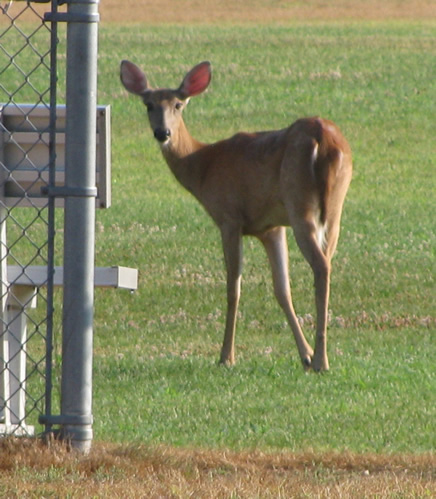
Observer: Paul Lauenstein
Observation Date: 4/21/18
Observation Time: 2:00 p.m.
Observation Location: 4 Gavins Pond Road, Sharon
Common Name: white-throated sparrow
Scientific Name: Zonotrichia albicollis
Comments: This species passes through Sharon in spring on its way to Canada. It’s distinctive song sounds like, “Oh, say, Canada Canada Canada.”
More Information: All About Birds
Observer: Paul Lauenstein
Observation Date: 4/27/24
Observation Time: 5:45 p.m.
Observation Location: Moose Hill Farm (TTOR)
Common Name: White-throated Sparrow
Scientific Name: Zonotrichia albicollis
Comments: This sparrow passes through Sharon in spring on its way to Canada. Its distinctive song sounds like, “Oh, say, Canada Canada Canada.”
The photos show two different white-throated sparrows, which I encountered in the same place. I assumed one was the male and the other was the female, but that assumption might not be correct. See: https://www.northcountrypublicradio.org/news/story/11424/20140904/variety-matters-among-white-throated-sparrows
More Information: All About Birds
Observer: Paul Lauenstein
Observation Date: 5/14/14
Observation Time: 10:50 a.m.
Observation Location: Moose Hill Audubon Wildlife Sanctuary
Common Name: White-throated sparrow
Scientific Name: Zonotrichia albicollis
Comments: The song of the white-throated sparrow sounds like, “Oh, say, Canada-Canada-Canada.” It is a reminder that they are only passing through Sharon on their annual migrations.
More Information: All About Birds
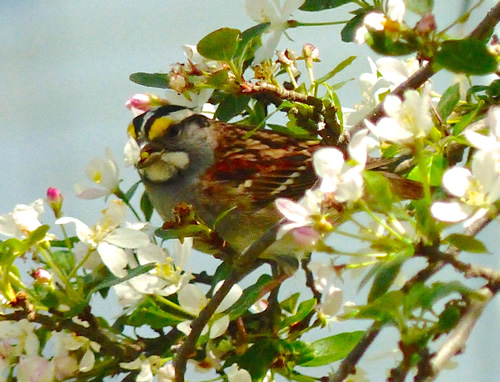
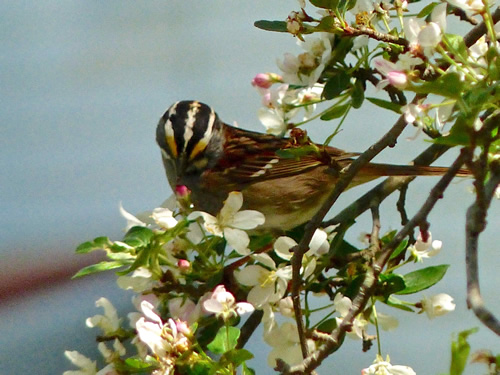
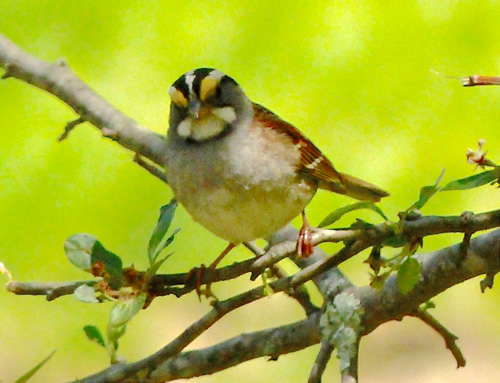
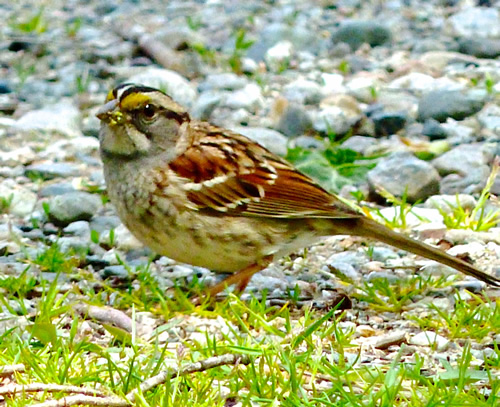
Observer: Paul Lauenstein
Observation Date: 5/16/23
Observation Time: 8:00 a.m.
Observation Location: Moose Hill Audubon Wildlife Sanctuary
Common Name: White-throated Sparrow
Scientific Name: Zonotrichia albicollis
Comments: This sparrow passes through Sharon in spring on its way to Canada. Its distinctive song sounds like, “Oh, say, Canada Canada Canada.”
More Information: All About Birds
Observer: Paul Lauenstein
Observation Date: 6/14/09
Observation Time: 11:30 a.m.
Observation Location: Moose Hill Farm, Trustees of Reservations land
Common Name: Whorled Loosestrife
Scientific Name: Lysimachia quadrifolia
More Information: Wild Flowers of Sleepy Hollow Lake
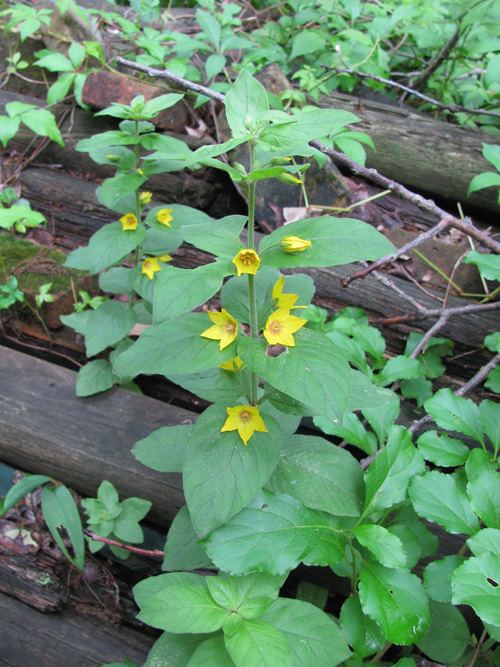
3 Whorls:
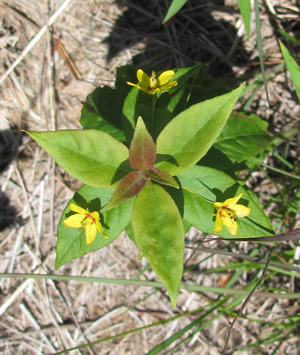
4 Whorls:
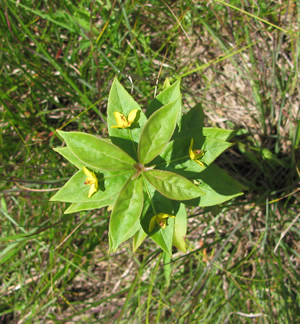
5 Whorls:
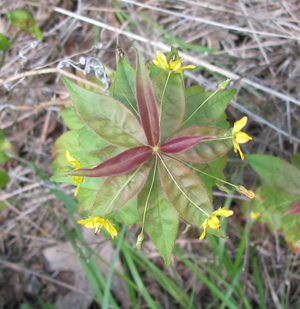
Observer: Paul Lauenstein
Observation Date: 9/4/20
Observation Time: 1:10 p.m.
Observation Location: Moose Hill Farm (in the woods)
Common Name: Whorled Wood Aster
Scientific Name: Oclemena acuminata
Comments: Whorled Wood Asters are among the relatively few woodland wildflowers that bloom in late summer and early fall.
Note the pure gold-green sweat bee feeding on the blossoms.
More information: Wildflowers of the Adirondacks
Observer: Paul Lauenstein
Observation Date: 7/3/10
Observation Time: 8:05 a.m.
Observation Location: near Gavins Pond
Common Name: Widow Skimmer dragonfly
Scientific Name: Libellula luctuosa
Comments: Odonates (dragonflies) are completely harmless – they do not sting or bite. Indeed, they are beneficial in the same way spiders and other predators are beneficial – they keep the burgeoning insect population in check.
More Information: North American Insects and Spiders
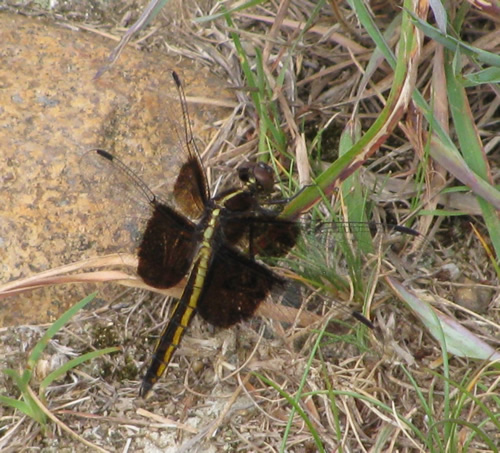
Observer: Paul Lauenstein
Observation Date: 7/31/11
Observation Time: 3:45 p.m.
Observation Location: Gavins Pond Road
Common Name: Widow Skimmer dragonfly
Scientific Name: Libellula luctuosa
Comments: The widow skimmer is famous for its pruinosity – the white, waxy coating on the dragonfly’s wings and abdomen. Dragonflies have excellent eyesight. Their compound eyes have up to 30,000 facets, each of which is a separate light-sensing organ or ommatidium, arranged to give nearly a 360° field of vision.
More Information: CirrusImage
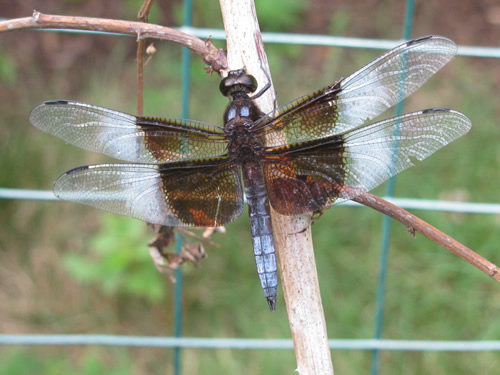
Observer: Josh Simons
Observation Date: 7/7/20
Observation Time: 1:30 p.m.
Observation Location: Moose Hill area
Common Name: Widow Underwing moth
Scientific Name: Catocala vidua
Comments: The widow underwing (Catocala vidua) is a moth of the Erebidae family. It is found from southern Ontario, into Maine, New Hampshire and Connecticut, south at least to Tennessee, Georgia and Alabama, west to Texas and Oklahoma, and north to Wisconsin.
More Information: iNaturalist and Bugguide.net and Discover Life and EverythingAbout.net
Observer: Paul Lauenstein
Observation Date: 5/21/16
Observation Time: 3:20 p.m.
Observation Location: Kendall Estate, Moose Hill Street
Common Name: Wild geranium
Scientific Name: Geranium maculatum
Comments: Geranium maculatum, the wild geranium, spotted geranium, or wood geranium, is a perennial plant native to woodlands of eastern North America, from southern Manitoba and southwestern Quebec south to Alabama and Georgia and west to Oklahoma and South Dakota.
More Information: Wikipedia
Observer: Paul Lauenstein
Observation Date: 5/23/18
Observation Time: 9:30 a.m.
Observation Location: Moose Hill Audubon Wildlife Sanctuary
Common Name: Wild geranium
Scientific Name: Geranium maculatum
Comments: Geranium maculatum, the wild geranium, spotted geranium, or wood geranium, is a perennial plant native to woodlands of eastern North America, from southern Manitoba and southwestern Quebec south to Alabama and Georgia and west to Oklahoma and South Dakota.
More Information: Wikipedia
Observer: Paul Lauenstein
Observation Date: 5/26/19
Observation Time: 2:45 p.m.
Observation Location: Moose Hill Farm (formerly the Kendall Estate)
Common Name: Wild geranium
Scientific Name: Geranium maculatum
Comments: Geranium maculatum, the wild geranium, spotted geranium, or wood geranium, is a perennial plant native to woodlands of eastern North America.
More Information: USDA Forest Service
Observer: Paul Lauenstein
Observation Date: 6/5/11
Observation Time: 3:20 p.m.
Observation Location: Kendall Estate, Moose Hill Street
Common Name: Wild geranium
Scientific Name: Geranium maculatum
Comments: Geranium maculatum, the wild geranium, spotted geranium, or wood geranium, is a perennial plant native to woodlands of eastern North America, from southern Manitoba and southwestern Quebec south to Alabama and Georgia and west to Oklahoma and South Dakota.
More Information: Wikipedia
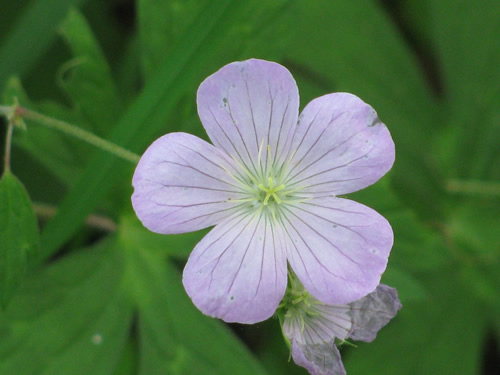
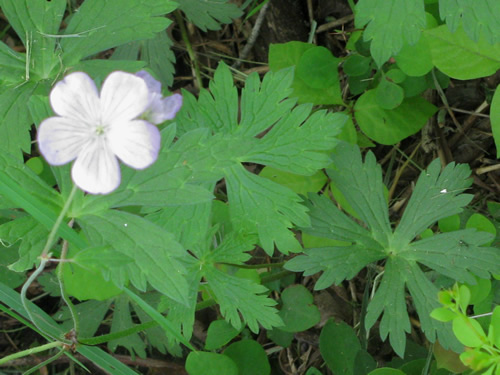
Observer: Paul Lauenstein
Observation Date: 9/7/20
Observation Time: 5:30 p.m.
Observation Location: Conservation land at Morse & Lakeview
Common Name: Wild Grapes
Scientific Name: Vitis spp.
Comments: Wild grapevines are native to eastern North America.
I smelled these wild grapes before I saw the grapevine laden with purple fruit climbing a tree beside the trail.
Be careful not to confuse wild grapes, which are edible, with Canadian Moon Seeds, which are poisonous.
More Information: Identifying Wild Grapes or Gardening Knowhow
Observer: Paul Lauenstein
Observation Date: 6/6/11
Observation Time: 2:20 p.m.
Observation Location: field near Gavins Pond Dam
Common Name: Wild Indigo
Scientific Name: Baptisia australis
Comments: It is a perennial upright bushy plant with attractive foliage. Blossoms in mid-summer are bright yellow. Seed heads turn a deep indigo color providing winter interest.
More Information: Wikipedia
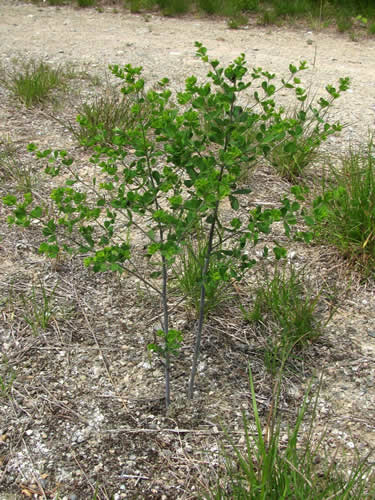
Observer: Paul Lauenstein
Observation Date: 7/22/15
Observation Time: 5:00 p.m.
Observation Location: field near Gavins Pond Dam
Common Name: Wild Indigo
Scientific Name: Baptisia australis
Comments: It is a perennial upright bushy plant with attractive foliage and yellow blossoms. Seed heads turn a deep indigo color providing winter interest.
More Information: Wikipedia
Observer: Paul Lauenstein
Observation Date: 6/9/13
Observation Time: 2:15 p.m.
Observation Location: Gavins Pond area
Common Name: Wild Iris
Scientific Name: Iris virginica shrevei
Comments: These gorgeous flowers bloom in spring around Sharon. These are also known as Harlequin Blueflag and Northern Blue Flag. Look for them in swamps, marshes, and wet shorelines from Virginia to Canada. Watch honeybees and native bees land on the large petal, which must look AMAZING in their ultraviolet-shifted vision, and scoot down into the nectary through the roofed-over passage. Sometimes they’ll exit on the side if they are small enough.
More Information: Backyard and Beyond
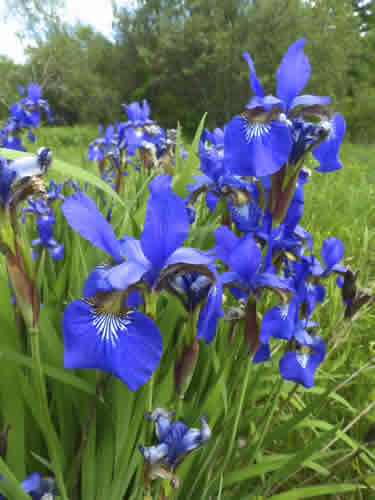
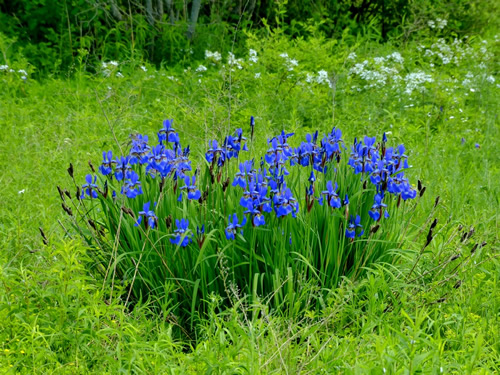
Observer: Paul Lauenstein
Observation Date: 5/12/11
Observation Time: 8:35 a.m.
Observation Location: Gavins Pond Road near soccer field parking lot
Common Name: Wild mustard
Scientific Name: Barbarea vulgaris Aiton
Comments: Also called yellow rocket, or early winter cress, introduced from Eurasia.
More Information: Wikipedia
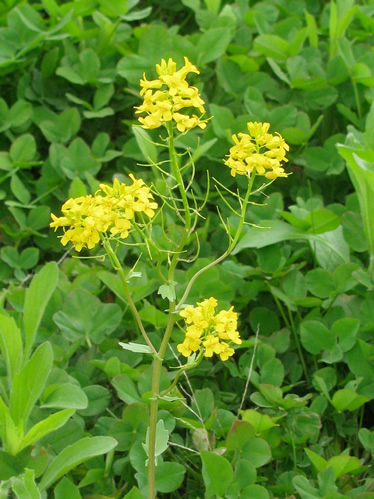
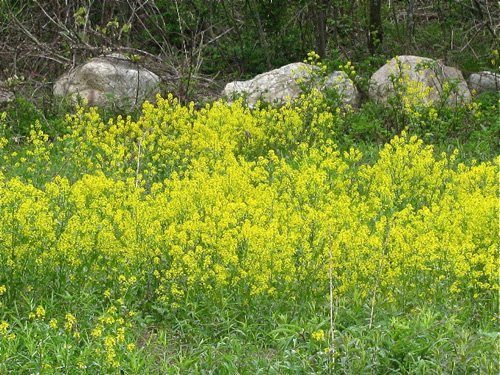
Observer: Paul Lauenstein
Observation Date: 7/7/18
Observation Time: 12:50 p.m.
Observation Location: Moose Hill Farm (TTOR)
Common Name: Wild Onion or Crow Garlic
Scientific Name: Allium vineale
Comments: Instead of flowers, they have bulbils, which are miniature sprouts not unlike garlic cloves.
Observer: Paul Lauenstein
Observation Date: 10/2/13
Observation Time: 12:15 p.m.
Observation Location: woods near Beaver Brook
Common Name: Wild Sarsaparilla
Scientific Name: Aralia nudicaulis
Comments: You might know Sarsaparilla as a sweet soft drink that was first introduced in the 19th century. Wild sarsaparilla is a common plant found in the northern and eastern parts of North America and grows on creeping underground stems. This plant was used as food when hunting or during wars because it was so sustaining. Wild sarsaparilla had a much wider use among native people because of its many medicinal purposes that treated everything from sores to toothaches.
While going through old photos on my computer, I came across this photo of yellow leaves. I opened an app on my cell phone called Seek by iNaturalist and pointed the phone at my computer monitor. The app immediately identified the leaves as wild sarsaparilla.
More Information: Stories from the Wigwam
Observer: Paul Lauenstein
Observation Date: 4/27/23
Observation Time: 3:30 p.m.
Observation Location: Moose Hill Farm (TTOR) along dirt road under high tension wires
Common Name: Wild strawberry
Scientific Name: Fragaria virginiana
Comments: Found in patches in fields and dry openings, this plant produces tasty strawberries.
More Information: Lady Bird Johnson Wildflower Center
Observer: Paul Lauenstein
Observation Date: 3/12/24
Observation Time: 5 p.m.
Observation Location: Moose Hill Audubon Wildlife Sanctuary
Common Name: Wild Turkey
Scientific Name: Meleagris gallopavo
Comments: Wild turkeys are often seen near the headquarters building of the Moose Hill Audubon Wildlife Sanctuary. They glean bird seed that spills from the bird feeders onto the ground.
More Information: All About Birds
Observer: Josh Simons
Observation Date: 3/18/11
Observation Time: 8:00 a.m.
Observation Location: Moose Hill area
Common Name: Wild Turkey
Scientific Name: Meleagris gallopavo
Comments: One of our largest and heaviest birds; smaller than a Trumpeter Swan; about twice the size (and four times as heavy) as a Ring-necked Pheasant. However, they can still fly. At night, groups of turkeys roost in trees.
More Information: Cornell Lab of Ornithology “All About Birds”
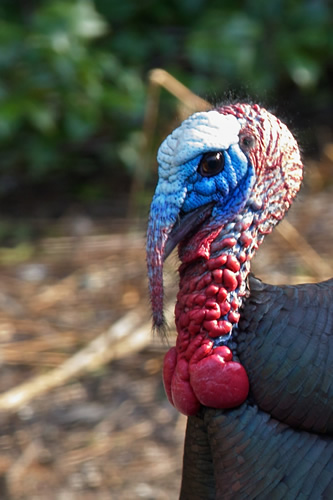
Observer: Paul Lauenstein
Observation Date: 4/30/18
Observation Time: 8:00 a.m.
Observation Location: Moose Hill Audubon
Common Name: Wild Turkey
Scientific Name: Meleagris gallopavo
Comments: Male (“tom”) turkeys display in springtime mating season to compete for status and the opportunity to mate.
More Information: All About Birds
Observer: Paul Lauenstein
Observation Date: 5/13/19
Observation Time: 9:00 a.m.
Observation Location: Moose Hill Audubon Wildlife Sanctuary
Common Name: Wild Turkey
Scientific Name: Meleagris gallopavo
Comments: As wild turkey numbers dwindled through the early twentieth century, people began to look for ways to reintroduce this valuable game bird. Initially they tried releasing farm turkeys into the wild but those birds didn’t survive. In the 1940s, people began catching wild birds and transporting them to other areas. Such transplantations allowed Wild Turkeys to spread to all of the lower 48 states (plus Hawaii) and parts of southern Canada.
More Information: All About Birds
PS – Check out this documentary called “My Life as a Turkey”: https://www.documentarystorm.com/my-life-as-a-turkey/
Observer: Ilan Fisher
Observation Date: 5/20/20
Observation Time: 5:00 p.m.
Observation Location: Bayberry Drive
Common Name: Wild Turkey
Scientific Name: Meleagris gallopavo
Comments: Red team vs. Blue team – truly American birds! So much so that Ben Franklin thought the wild turkey would be preferable to the bald eagle as a national symbol. See: https://www.history.com/news/did-benjamin-franklin-propose-the-turkey-as-the-national-symbol
More Information: All About Birds
Observer: Peter Higgins
Observation Date: 6/8/08
Observation Time: 6:15 a.m.
Observation Location: Moose Hill Farm
Common Name: Wild Turkey
Scientific Name: Meleagris gallopavo
Comments: This was my first venture to Moosehill Farm in the early hours and seeing this group of Tom Turkeys strutting their stuff got me hooked. Since that time I go up as often as possible. A week ago I stood quietly at the edge of a field and something caught my eye, a coyote was running full speed across the field.
More Information: Cornell Lab of Ornithology “All About Birds”

Additional Photos:

Observer: Paul Lauenstein
Observation Date: 7/14/21
Observation Time: 2:45 p.m.
Observation Location: my back yard (4 Gavins Pond Rd.)
Common Name: Wild Turkey
Scientific Name: Meleagris gallopavo
Comments: I photographed this hen and her chicks out my bedroom window.
More Information: All About Birds
Observer: Judy Heap
Observation Date: 8/11/10
Observation Time: evening
Observation Location: Wilshire Drive backyard
Common Name: Wild Turkey
Scientific Name: Meleagris gallopavo
Comments: Wild turkeys can be aggressive, so keep a safe distance.
More Information: Cornell Lab of Ornithology “All About Birds”
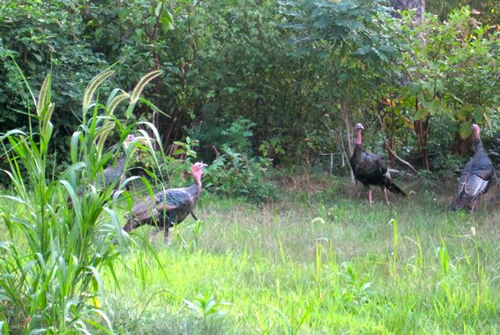
Observer: Deb Radovsky
Observation Date: 5/5/18
Observation Time: 8:50 a.m.
Observation Location: Moose Hill, Kettle Trail
Common Name: Wild Turkey
Scientific Name: Meleagris gallopavo
Comments: As Wild Turkey numbers dwindled through the early twentieth century, people began to look for ways to reintroduce this valuable game bird. Initially they tried releasing farm turkeys into the wild but those birds didn’t survive. In the 1940s, people began catching wild birds and transporting them to other areas. Such transplantations allowed Wild Turkeys to spread to all of the lower 48 states (plus Hawaii) and parts of southern Canada.
More Information: All About Birds
Observer: Liz Dichiara
Observation Date: 3/21/09
Observation Time: 5:45 p.m.
Observation Location: Cheryl Drive
Common Name: Wild Turkeys
Scientific Name: Meleagris gallopavo
Comments: Two beautiful males and five females walked through my wooded backyard today. The males were displaying to the females, who did not appear impressed.
More Information: All About Birds: Wild Turkey
Observer: Ilan Fisher
Observation Date: 5/18/18
Observation Time: 8:00 p.m.
Observation Location: Bayberry Drive
Common Name: Wild Turkey
Scientific Name: Meleagris gallopavo
Comments: The Wild Turkey’s popularity at the table led to a drastic decline in numbers, but they have recovered and now occur in every state except Alaska.
Poor guy. He is bonkers for the chick. I wonder if his broken tail feathers will thwart his plan.
More Information: All About Birds
Observer: Paul Lauenstein
Observation Date: 5/31/20
Observation Time: 3:00 p.m.
Observation Location: Moose Hill Farm (TTOR)
Common Name: Wild Violet
Scientific Name: Viola odorata
Comments: V. odorata is native to Europe and Asia, but has also been introduced to North America and Australia. It is a hardy herbaceous flowering perennial.
More Information: Wikipedia
Observer: Paul Lauenstein
Observation Date: 5/7/19
Observation Time: 8:00 a.m.
Observation Location: Moose Hill Audubon Wildlife Sanctuary
Common Name: Wild Violet
Scientific Name: Viola odorata
Comments: V. odorata is native to Europe and Asia, but has also been introduced to North America and Australia. It is a hardy herbaceous flowering perennial.
More Information: Wikipedia

